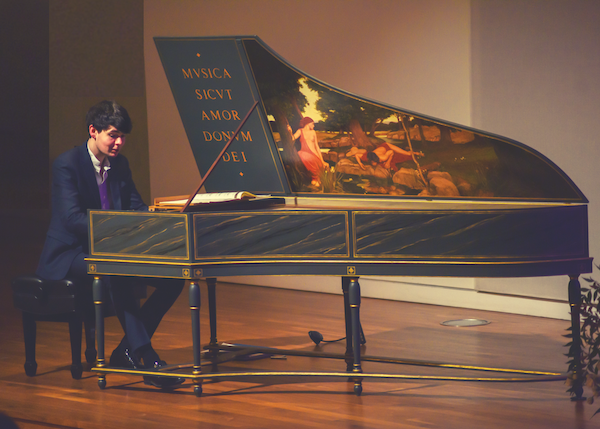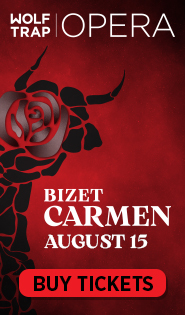Taylor takes audience on a lively and illuminating Italian tour for Capriccio Baroque

Justin Taylor performed a recital for Capriccio Baroque Saturday night. Photo: Corbin Phillips
Justin Taylor has had a remarkable career for a 30-year-old. After winning first prize at the Musica Antiqua Harpsichord Competition in Bruges in 2015, he has released a series of acclaimed recordings for both Alpha and Deutsche Grammophon.
The French-American harpsichordist returned to the Capriccio Baroque series Saturday evening, for an exploration of Italian influence on Bach’s music, heard at First Congregational UCC.
Taylor is known for curating intelligent programs, as he did on a dazzling streamed concert of music by Domenico Scarlatti and Soler, broadcast last year by the Library of Congress. Last night’s concert paired a selection of Italian concerto transcriptions, by Vivaldi and others, that Bach made largely during his second stint at the court of Weimar, from 1708 to 1717, along with some of the composer’s own attempts at the Italian style.
Playing on a two-manual harpsichord by British maker Colin Booth, modeled on a 1710 instrument by J.C. Fleischer, Taylor displayed his fluent technique first on Bach’s Chromatic Fantasia in D Minor. With striking independence and accuracy of every finger, his hands moved with ease through the roiling triplets, even faster 32nd-note runs, and freely arpeggiated chords, enlivening the dense chromaticism with rubato. A subtle shift of registration gave a softer intimacy to the recitative section of the piece.
Bach based his Harpsichord Concerto in D Major on one of the violin concertos from Vivaldi’s collection L’estro armonico. Allowing no applause for the previous work, Taylor launched a swift and lively rendition of the first movement, using registration changes to capture the orchestral differentiation of solo episodes from tutti sections. Rhythmic manipulation stretched the slow movement, with rolled effects added to most of the accompanying chords. After a tinkly introduction to the third movement, played like twin violins in parallel thirds, Taylor crashed into the tutti section with the harpsichord’s fullest registration, a startling effect.
Taylor added two selections not printed in the program, beginning with his own arrangement of the slow movement from Vivaldi’s Flautino Concerto in C Major. This was a piece Taylor said he has “fallen in love with” in the last several weeks, and he embroidered its lovely melody with intricate ornamentation. The piece served as a melancholy introduction to Bach’s Toccata in E Minor, which was mercurial in its flights of fancy, the changes of musical character heightened by registration adjustments. (At one point Taylor tuned a couple of strings that had soured a bit, but he chose not to take up technician Barbara Wolf’s offer to do a more thorough, mid-recital tuning.)
The middle movement of Bach’s Organ Concerto in D Minor, also based on Vivaldi and floridly ornamented, made a moving introduction to the heart of the program. This was the Italian Concerto in F Major, Bach’s most famous attempt to put the lessons from Vivaldi into practice.
Taylor highlighted the orchestral structure of the first movement, including some subtle echo effects. Unlike in the slow movements of the transcriptions, Taylor gave this work’s central Andante a hypnotic pacing. Singling out each element of the accompaniment and the rich melody with varied rubato, he brought out the sturdy pedal part on low D that undergirded the conclusion. The Presto finale bounced with just the right degree of jollity, especially its signature ritornello, a scale rushing upward two octaves.
Taylor inserted one more Italian piece into the mix, some flashy excerpts of the first-movement cadenza from another Bach organ concerto, reworked from Vivaldi’s “Grosso Mogul” concerto. This display piece, especially the rolling chord figuration, brilliantly introduced the fanfare-like opening of Bach’s Harpsichord Concerto in F Major, based on another violin concerto from Vivaldi’s L’estro armonico. After a somewhat plain slow movement, the concluding Presto offered more challenges easily surmounted by Taylor’s agile fingers.
The program closed with a delightful pairing spotlighting Taylor’s musical range, beginning with a gorgeous reading of the Adagio movement from Bach’s Concerto in D Minor, based on a famous oboe concerto by Marcello. Bach’s Toccata in D Major, a tour de force in six contrasting movements, which Taylor negotiated with exceptional savvy, combined poignant vignettes with mercurial fast sections, especially the concluding fugue.
For encores, Taylor outdid himself with a French selection. The infectious dance of “Les Sauvages” from Rameau’s Les Indes Galantes, was fitted out with jaw-dropping variations composed by Jean-François Tapray. To send the enthusiastic audience home, he returned to his “favorite piece,” that fascinating slow movement from the Flautino Concerto in C Major. It was easy to hear why it had become Taylor’s latest obsession.
Harpsichordist Lillian Gordis and viola da gambist Jérôme Hantaï will perform music by Bach, F. Couperin, Marais, and Forqueray 8 p.m. April 29 at St. Thomas’s Parish Church. capricciobaroque.org


